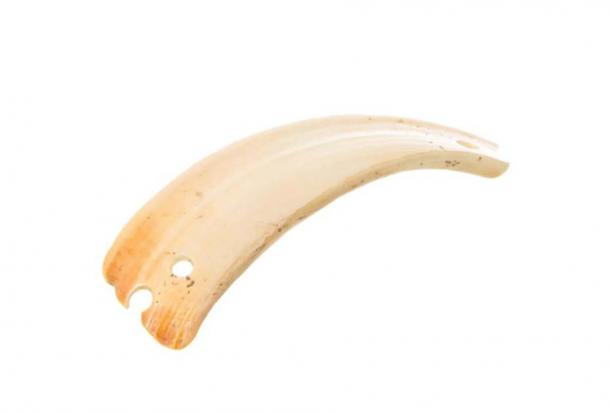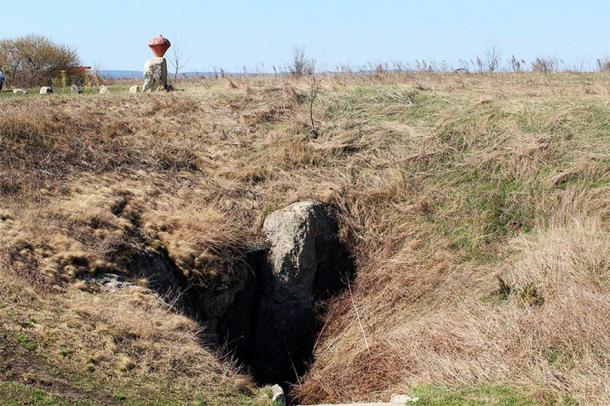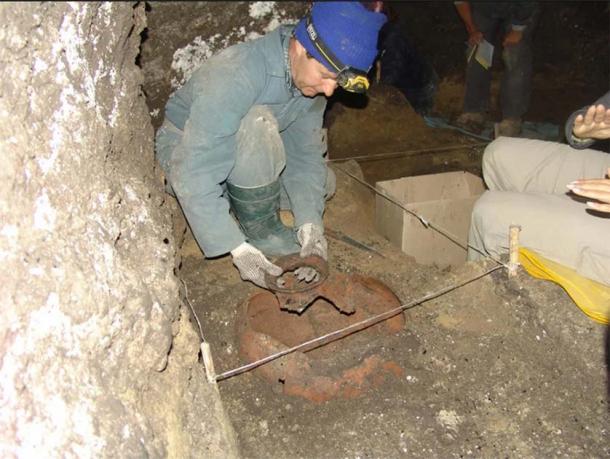
Trypillian Culture Female Figurines Found at Ukraine’s “Pompeii”
A team of archaeologists from the Ukraine discovered five clay female figurines hidden inside a hole in a wall in Verteba Cave, in the Borshchiv Region of western Ukraine. Dating to the first millennium BC, these stylized figurines have been linked to the Cucuteni-Trypillian culture, which dominated a large swath of Eastern Europe during the Late Neolithic period and the Copper Age (6,000 to 2,750 BC).
What Makes These Trypillian Culture Figurines So Special?
The figurines were likely used during Trypillian ceremonial practices. Archaeologists have identified statuettes like these as totems or fetishes, which are sacred objects that can protect people from harm. In this case the figurines were placed inside the cave wall and covered with an unusual seal for reasons that are just as obscure.
- Ancient “Hieroglyphs” Discovered In Ukrainian Caves
- The Mysterious House-Burning of the Forgotten Cucuteni-Trypillian Culture
“Female figurines are not rare in Trypillian contexts, and hoards of figurines are known," confirmed Sokhatskyi Mykhailo, a scholar of the Trypillian culture and the director of the Borschivskyy Local History Museum, in an interview published in Haaretz. “But these were sheltered by the tusks of a wild boar.” He emphasized that this arrangement was unique, having never been seen before at any Eastern European archaeological site.
Boar remains have been found at ancient Trypillian sites in the past, but not too often. The occasional tusk has been unearthed during graveyard excavations, but for the most part the Trypillian culture focused its rituals on domesticated animals like cattle, sheep, goats and dogs. This was in keeping with their agricultural lifestyle.

Archaeologist Mykhailo Sokhatskyi conducting excavations at Verteba Cave in the Ukraine, where evidence of the Trypillian culture has been found. (Mykhailo Sokhatskyi)
Boar-Worshipping Trypillian Culture Unearthed at Verteba Cave
Interestingly, however, it appears that the people who used Verteba Cave in the western Ukraine had a closer relationship with the boar than most other groups of the Cucuteni-Trypillian culture. Other excavations at the cave by the same team unearthed jewelry and pottery production tools made from boar teeth, and in 2016 they found a small boar figurine made from the same type of clay as the newly discovered female statuettes.
Sokhatskyi noted that the Trypillians had a habit of resurrecting old cultural traditions. They were known to reuse pottery ornamentation styles periodically, and the scholar speculates that some remnant of an ancient boar-worshipping culture may have been preserved by the people who occupied Verteba Cave.

Boar tusk found at Verteba Cave in the Ukraine includes perforations which suggest that it was used as a pendant or some other kind of adornment. (Mykhailo Sokhatskyi)
The Story of Verteba Cave and its Trove of Trypillian Culture Artifacts
First discovered in 1829, Verteba Cave is a 5.6 mile-long (9 km) linear-shaped cavern that features a complex maze of tunnels, only some of which are large enough to navigate. Its entrance can be found near the village of Bilche-Zolote north of the Dniester River in western Ukraine. It has been heavily excavated over the past 200 years and is often referred to as “Pompeii on the Dniester” because of the incredible volume of ancient artifacts that have been unearthed inside it.
The cave’s primary users were the people of the Cucuteni-Trypillian culture. Emerging simultaneously with the dawn of agriculture in Eastern Europe, the Cucuteni-Trypillian people (often referred to simply as the Trypillians) occupied the lands of modern-day Moldova, western Ukraine and northeastern Romania for approximately 2,000 years, likely dating from the earliest part of the Late Neolithic and Copper Age period (6,000 to 4,000 BC, give or take a few centuries).
At their population peak Trypillian settlements could be found spread out over an area that covered 140,000 square miles (350,000 sq km), extending from the Carpathian Mountains in Romania to the Dniester River valley region.
Over the past two centuries archaeologists exploring the depths of this dark and dank cave have unearthed an astounding collection of ornamented pottery, clay figurines made in the images of people, animals and goddesses, multipurpose tools made from stone and animal bones, copper knives and decorative jewelry made from bones and shells. These items have been found in three different excavation layers, revealing that Trypillian people used the cave intermittently rather than occupying it continuously.
Archaeologists have uncovered a range of artifacts from different eras suggesting that the Cucuteni-Trypillian culture used Verteba Cave for ritual worship and other activities for approximately 800 years in total. Much of what has been discovered there has been left in place or put on display right where it is, creating a sort of underground Trypillian museum that is open to the public (guided tours are offered).

The hidden entrance to Verteba Cave in the Ukraine. (Педагог Світлана / CC BY-SA 4.0)
Verteba Cave: A Refuge or Entrance to the Underworld?
It should be noted that Verteba Cave is narrow, extremely humid and difficult to navigate without getting lost. Consequently, it is unlikely that any groups relied on it to provide permanent shelter. Most likely it would have been used as a place where religious ceremonies could be performed - the Trypillians may have believed it was an entrance to the underworld or the land of the dead - and as a place to hide during military conflicts or invasions.
Evidence shows that migration into Trypillian territory near the Dniester was common. As population density grew, conflicts between different groups over land and resources would have been inevitable. Because it was so difficult to access, Verteba Cave might have been seen as a safe refuge by locals who’d mapped its corridors after using it for ritual purposes over many generations. Its only surviving entrance is located at the bottom of a sinkhole on a flat plateau, which would have been difficult for invading newcomers to find.
- Ukraine Officials Rush to Stop Destruction of Ukrainian Heritage
- Ukrainian Burial Mound Dig Reveals 5,500-Year-Old Stonehenge-like Structure
In support of this latter thesis, archaeologists who’ve excavated Trypillian settlements in the region have discovered the ruins of fortifications (walls and towers), along with remnants of moats that had been built to surround important buildings. Even more ominously, the well-preserved skulls of 12 out of 21 Trypillians unearthed between 2008 and 2012 at various locations showed signs of head trauma that had not healed (implying the trauma was the cause of death). While accidents could have caused such trauma, the nature and location of the skull breakage suggested it was caused by intentional blows.
If Verteba Cave was used as an occasional refuge and not just for worship, that would explain why such a large collection of artifacts have been found inside a cavern unsuitable for permanent residence.

Archaeologists finding a storage jar in Verteba Cave, where evidence of the Trypillian Culture has been unearthed. (Mykhailo Sokhatskyi)
Rediscovering the Secrets of the Cucuteni-Trypillian Culture
In addition to discovering the female figurines, during their most recent explorations the Borschivskyy Local History Museum archaeologists also excavated a huge clay storage jar that contained some type of white organic material. They have yet to analyze the mysterious substance, and at this point have no idea what it might be or why it was preserved.
The enigmatic nature of the new findings at Verteba Cave in the Ukraine highlight how difficult it has been for archaeologists to uncover the truth about the cultural and spiritual practices of Eastern Europe’s Cucuteni-Trypillian people. But each new discovery adds another piece to a complex puzzle, bringing scholars closer to a true understanding of how the creators of this lost ancient culture lived and worshipped.
Top image: Female figurines dating back to the Cucuteni-Trypillian Culture unearthed at Verteba Cave. Source: Mykhailo Sokhatskyi
By Nathan Falde















